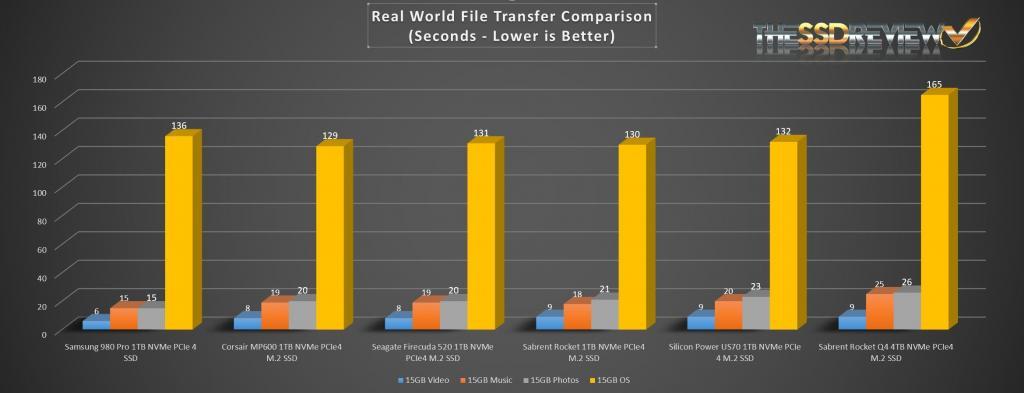REAL WORLD FILE TRANSFER COMPARISON
We have put the Sabrent Rocket Q4 Gen 4 NVMe SSD beside a few of the best PCIe 4.0 SSDs in the business for our true to life data testing. In this test, we simply place 15GB files representing music, video, pictures and operating systems onto the target drive. We then copy each file from one place on the target disk to another, recording the time taken for the transfer.
We might have expected to see a bit more from a Gen 4 SSD, however, this is a rather extraordinary drive as it is a 4TB Gen 4 SSD.
REVIEW ANALYSIS AND FINAL THOUGHTS
Sabrent SSDs have literally changed the dynamic of the SSD marketplace and they have done it through unexpected SSD releases, great prices, performance and warranty. The Sabrent 4TB Rocket Q4 Gen 4 NVMe SSD is a perfect example of that, where we are seeing amazing capacity, paired with great Gen 4 speeds, a 5-year warranty along with great pricing. This doesn’t discount the fact that Sabrent has built a great reputation in what could only be a very short time in the SSD industry.
The Sabrent 4TB Rocket Q4 Gen 4 NVMe SSD gave us testing results in excess of 5GB/s read and just under 4GB/s write throughput with 739K read and 681K write IOPS at low 4K disk access. To be able to offer this at $749.99 is a great price, especially when the package also includes a free copy of Acronis True Image Disk Migration software and, instructions, as well as access to a free download of Sabrent’s own Rocket Control Center, as seen here:
4TB capacity. Gen 4 performance. 5-Year warranty. Great pricing and a solid reputation. Great job Sabrent!
Check out Sabrent 4TB Rocket Q4 Gen 4 NVMe Pricing at Amazon.
 The SSD Review The Worlds Dedicated SSD Education and Review Resource |
The SSD Review The Worlds Dedicated SSD Education and Review Resource | 


Dear Les,
I think there is a typo in the last few sentences on the first page, were the per seconds part should not be there after the capacity in megabyte (gigabyte, after all?) “… 3725MB/s available for user storage once formatted …”
Is the difference related to the 1000 vs 1024 marketing thingy or simply to overprovisioning practices.
Also, while on topic of overprovisioning. I usually format and partition SSDs with Partition Guru. The way I do it is dividing the total capacity in bytes by the number of storage chips on the drive. Then I divide this by eight, so that I know how many 4K(=8 times 512 bytes) aligned sectors essentially there are. Then I size the very first part for EFI System Partition (ESP) to be large enough to contain the recommend 100 megabytes size. Whatever the amount in bytes, I subtract this from the result of the division, and create the first NTFS partition so that the sum of “the very first MBR sector + ESP + the first partition” is exactly, down to the byte, as large as a single chip can hold. To size the remaining partitions is simpler, as from that point on I only have to decide on exactly how many chips a given partition spans out over.
So, I usually get extremely, really down to the bytes precise results when examining the sector count boundaries afterwards. But on rare occasions I just brick the drive, simple as that …
And that made me wonder in trying to be this precise I inadvertedly wreak havoc in the overprovisioning proper, i.e. the way it is engineered on circuit logic level.
So, long story short, my question proper:
The overprovisioned part, say X percentage of a drive’s total capacity is …
a) an a single allocated and continuous area on one of the chips?
or
b) this X percentage is further divided by the number of chips, and each of them contains an equal sized OP area (the sum of which essentially being the X percentage in total)?
I do hope you can enligthen me 😉
Kind regards,
-Christian
Unfortunately, I cannot and thank you for replying. I don’t play with overprovisioning at all because…as you said… some drives brick. Typically, we want to test them to the extent that the reader can determine if it is the drive for them, and also so they can imitate same in their tests.